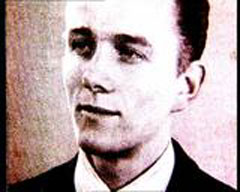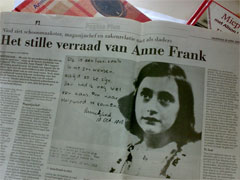
The Attic seen from the back.For eight Jewish people in hiding at Prinsengracht 263 in Amsterdam, a more than 2 year period of hiding came to an end on the warm summer's day of August 4, 1944. The doors to the stockroom stood open, and the first to enter was the Austrian Nazi SS Oberscharführer Karl Silberbauer, followed by the Dutch NSB members (Dutch national socialists, allied to the Nazis) Gezinus Gringhuis, Willem Grootendorst and Maarten Kuiper. The hiders were taken away (and apparently their number was more than expected, as a second car had to be called for), along with two of the four helpers present that day. The remaining staff was not interfered with. Click here to see a video excerpt in which Miep Gies recounts the day of the arrest.
Of the eight Jewish hiders, only Otto Frank returned after the war, as did the two arrested helpers Johannes Kleiman and Victor Kugler. The Secret Annex had been betrayed, but by who?
To this day, no-one has been able to answer that question with certainty, and the definite answer will probably never be known. The Political Investigation Department of the Amsterdam police force conducted an inquiry in 1948, and a second inquiry took place in 1963. In 2003, the Netherlands Institute for War Documentation released a report. In addition to these official reports, there are also the biographers of Anne Frank and of Otto Frank, Melissa Müller and Carol Ann Lee, who each attempt to identify the betrayer in their books published in 1998 and 2002, respectively. The question is also a matter of much speculation, with varying degrees of substantiation. Below follows an inventory of possible betrayers and the circumstances that could have brought them to the betrayal. Every reader will have to draw his or her own conclusions.
The coincidence
As the period of hiding went on for longer, the hiders became less careful. Curtains were opened beyond just a crack, rooftop windows inadvertently stayed open, accidental noises became more frequent, and so on. All in all, the visible evidence mounted for the world outside that there were people in the building after office hours. People in the outside world may quite innocently have mentioned this in conversation, which could have been overheard by the wrong persons. In this scenario, the name of the night watchman Martin Sleegers plays a prominent role. Following the report of a burglary in the premises in April 1944, he and a police officer went to investigate. They actually fumbled with the bookcase that hid the entrance to the Secret Annex. Anne describes this burglary in her diary entry of April 11, 1944. There is no concrete evidence that Sleegers betrayed the hiders. While it is a fact Sleegers knew the NSB member Gringhuis (who was present at the arrest), this in itself does not constitute proof.
Tonny Ahlers
NSB member Tonny Ahlers visited Otto Frank at his office in April 1941, to confront him with a letter addressed to the NSB that mentioned a conversation between Frank and Job Jansen, a former employee. In this conversation, Otto Frank had expressed negative views about the German occupier. Ahlers said that he worked as a courier for the SD (Nazi security service) and for the NSB, and said that he had intercepted the letter by chance. Subsequent investigations showed that he was indeed a frequent visitor at the Security Service, but that his role as courier was simply made up. It is known that Frank twice gave money to Ahlers, though probably not more than 50 guilders altogether. It has not been established that Ahlers visited Frank regularly.
Tonny AhlersAhlers was notoriously anti-Semitic, for which he was also convicted after the war, but also an inveterate liar and a braggart. This makes it difficult for researchers to distinguish fact from fiction. Can Ahlers have been the betrayer personally, or did he pass on information to the Nazi Security Service, for example? The latter is possible. Ahlers started a business in the same kind of commodities as Otto Frank's business. This would have given him access to the stockroom of Opekta / Pectacon, later Gies & Co., when coming to collect ordered goods at Prinsengracht. In this way he may also have had contact with the stockroom manager Willem van Maaren (more about him later). The three NSB members Gringhuis, Grootendorst, Kuiper and Sleegers and Ahlers all knew each other, but this doesn't really prove anything, certainly not given Ahlers' untrustworthiness. The facts are definitely striking and can be used to construct a plausible theory, but it will never amount to hard evidence. It is regrettable that Ahlers' widow, Martha van Kuik, was not interrogated extensively. She was an eye-witness and may have known and seen a great deal. She is still alive today. Carol Ann Lee, biographer of Otto Frank (2002), was the first to present this theory about Tonny Ahlers. In her book she works towards identifying Ahlers as the betrayer, yet without explicitly labeling him as such. It remains a speculative theory, woven into her pages. The Dutch television program Andere tijden, aired on March 12, 2002, explores Lee's theory.
Willem van Maaren
Stockroom manager Willem van Maaren was suspected of the betrayal for many years, although he never sided with the Nazis. He stole goods and was generally considered dishonest. In Anne's diary it becomes clear that the Annex occupants also did not trust him. However, inquiries conducted after the war did not turn up any evidence that he was the betrayer. On the other hand, his eager inquisitiveness was very striking. In all sorts of ways, he tried to establish whether people had entered the stockroom in the evening or during the night. From what he noticed, he must have concluded that this was indeed the case. Another very unusual moment occurred when he asked the employees whether there had previously been a Mr. Frank at the office. It is unknown how he came to that name, or why he asked that question. Van Maaren supplied goods to various customers, but it cannot be determined whether Ahlers was one of these. That Ahlers and Van Maaren knew each other, so that Van Maaren may have tried to obtain information for Ahlers, is yet another theory that sounds plausible but that cannot be proven.
Lena Hartog-van Bladeren
She is the least likely candidate for the role of betrayer. Her husband Lammert worked in the stockroom on Prinsengracht until the raid in 1944, while she worked as a cleaner at the same address (among others)— something that she initially denied, by the way. A second contradiction is Lammert's statement that he continued to work at the stockroom for several days following the raid, while according to the helpers he immediately ran off when the arrest took place. It can furthermore not be explained why Lena Hartog claimed that there were Jews hiding in the premises at number 263. Where could she have got this information? From her husband or from Van Maaren? The latter declared later to have had just a suspicion. So was there information trickling through a grapevine? Possibly, but hard to prove. Finally, Lena said that she feared for her husband, who worked in a place where Jews were hiding. But then why did she not warn her husband on the day the raid took place to avoid his arrest, and notify the Security Service afterwards? The Germans refers to their source as a 'reliable' source. Was it Lena? Anne Frank's biographer Melissa Müller first pointed to Lena Hartog as possible betrayer, in her 1998 book Anne Frank, The biography. Yet it remains unlikely, as she would have wanted as much as possible to avoid drawing attention to her family, given her husband's precarious position (he hadn't responded to the Arbeitseinsatz, the summons to work). 
Headline "The silent betrayal of Anne Frank" in Dutch newspaper after the NIOD report was published, April 28, 2003.To conclude
The above demonstrates that there is no indubitable proof for who betrayed the Secret Annex. There is something about all the persons and circumstances that make them suspicious, but precisely because this is so, all argumentation falters here. It could be that a number of persons suspected the presence of the hiders, and that a number of persons involved with the Prinsengracht address knew each other, but this does not add up to any form of evidence. Pure coincidence must moreover not be ruled out as a contributing factor. Perhaps neighbors sympathetic to or member of the NSB, who looked out on the rear facade of the premises, saw people moving past curtains that were not fully closed, and notified the authorities.
A few more 'loose ends' remain. For example, in late 1943 Victor Kugler was summoned to the local headquarters of the Nazi Party in his hometown of Hilversum, on the same night that the hiders on Prinsengracht were alarmed by an insistent ringing of the front doorbell. Kugler had apparently ignored the first summons, as the existence of the second summons demonstrates. Why was he summoned there, and what was discussed? And did the Austrian Silberbauer, who supervised the arrest, really not know who had tipped off the Amsterdam Security Service headquarters about the Jewish hiders, as he claimed during the investigation of 1963?
Practically everyone that had anything to do with the betrayal was interrogated after the war, without producing any definitive answer to the question, 'Who betrayed the occupants of the Secret Annex on Prinsengracht 263?'


